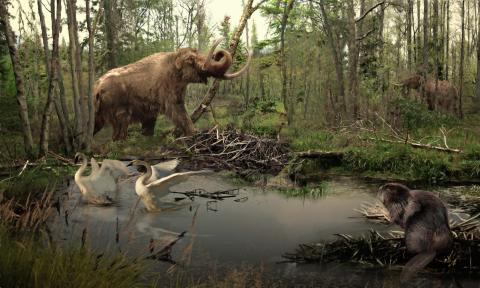Spruce Ash Forest
Reconstruction of the Mastodon Lake locality in Aurora, Illinois. Spruce and Black Ash forest characteristic of the southern Great Lakes at the end of the Ice Age. Image by Velizar Simeonovski.
This biome is characterized by a cold and wet climate promoting a woodland dominated by spruce and black ash with no modern analogue. A variety of coniferous and deciduous trees such as larch, fir, oak, elm, and hop hornbean are also present in lower percentages on the landscape. Deciduous elements spread into the Midwest for the first time since the last glacial maximum. The landscape itself is very wet. Lowlands and riparian areas are saturated, promoting the widespread development of wetlands and semi-aquatic plant communities dominated by sedges and bulrushes.
Animals found within this landscape included mastodons and relict mammoth populations. These two proboscideans are found together in the Bamford Farm site (Grundy Co., IL), although direct-dating of the specimens indicates they were not strictly contemporaneous. Other species occupying this environment included: Stag-Moose, Giant Beaver, Jefferson's ground sloth, and Helmeted muskox, as well as a small, mostly modern, carnivore guild (e.g., Fisher, Ermine). Although non-mammal records are rare for midwestern sites dating to this time period, Trumpeter Swan was found in association with mastodon and giant beaver at the Mastodon Lake locality in Aurora, IL.
Recently, studies of a coprophilus fungi found in lake deposits from this time period have been used to understand regional animal population patterns (Gill et al. 2009). Sporormiella is a fungus that occurs on the dung of large mammals. Researchers examining lake deposits in northern Indiana noted a decline in Sporormiella spores at this time, suggesting a similar decline in the amount of dung around the lake, a proxy for the presence of large mammals such as mastodons and ground sloths.











